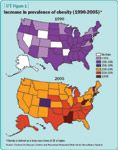Article
Metabolic syndrome and LUTS: An emerging relationship
Increasing evidence has recently pointed toward a relationship between LUTS secondary to BPH and the presence of metabolic syndrome. This relationship has been supported by recent epidemiologic findings.


Epidemiology of metabolic syndrome



LUTS/BPH and metabolic syndrome
A diagnosis of LUTS comprises a spectrum of irritative and obstructive voiding symptoms generally considered a sign of clinically significant BPH. The Third National Health and Nutrition Examination Survey (NHANES III) was a national cross-sectional health survey of 8,814 men and women in the United States conducted between 1988 and 1994 (JAMA 2002; 287:356-9). Subsequently, a subset of 2,372 men 60 years of age or older was evaluated for an association between LUTS and metabolic syndrome. This study found that the presence of LUTS was strongly associated with elevated glycosylated hemoglobin, an accurate predictor of a patient's glucose control over the previous 3 months. A history of diabetes mellitus (Odds Ratio [OR]=1.67) and history of hypertension (OR=1.76) also were found to correlate with the presence of LUTS. An inverse association between high-density lipoprotein levels and the presence of LUTS also was noted.





